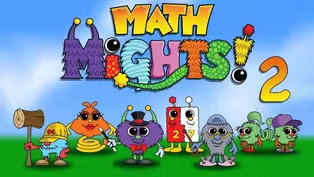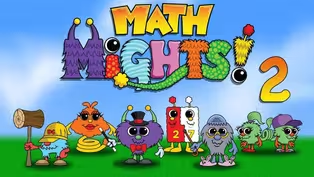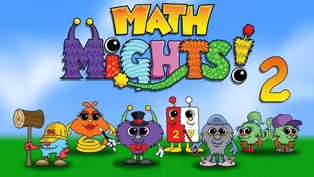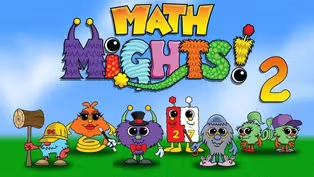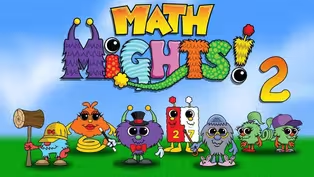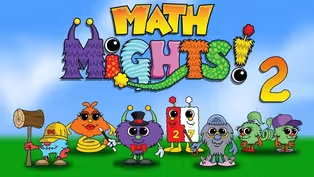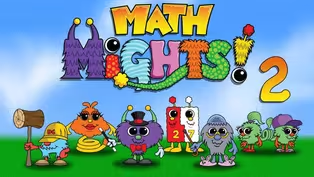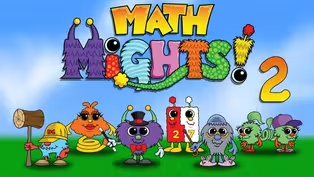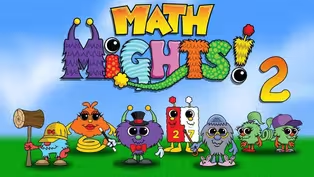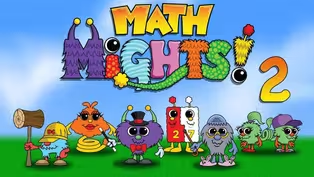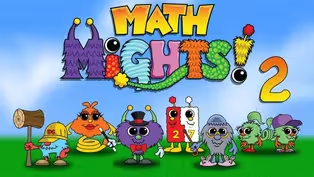Math Mights
Compare 3-Digit Numbers Part 2
Season 3 Episode 305 | 15m 59sVideo has Closed Captions
Join Mrs. McCartney to learn how to do a comparison word problem with Professor Barble!
Join Mrs. McCartney to learn how to do a comparison word problem with Professor Barble! Next we are going to work on comparing 3 Digit numbers with a game of true and false! Plus we will use numberline, Value Pak, Place Value discs and blocks to compare! Which tool will you pick to use?
Problems playing video? | Closed Captioning Feedback
Problems playing video? | Closed Captioning Feedback
Math Mights is a local public television program presented by Detroit PBS
Math Mights
Compare 3-Digit Numbers Part 2
Season 3 Episode 305 | 15m 59sVideo has Closed Captions
Join Mrs. McCartney to learn how to do a comparison word problem with Professor Barble! Next we are going to work on comparing 3 Digit numbers with a game of true and false! Plus we will use numberline, Value Pak, Place Value discs and blocks to compare! Which tool will you pick to use?
Problems playing video? | Closed Captioning Feedback
How to Watch Math Mights
Math Mights is available to stream on pbs.org and the free PBS App, available on iPhone, Apple TV, Android TV, Android smartphones, Amazon Fire TV, Amazon Fire Tablet, Roku, Samsung Smart TV, and Vizio.
Providing Support for PBS.org
Learn Moreabout PBS online sponsorshipMore from This Collection
"Math Mights" lessons for 2nd Grade students.
Video has Closed Captions
Join Mrs. McCartney for some fun with Professor Barble. (15m 59s)
Video has Closed Captions
Join Mrs. McCartney for some fun with Professor Barble. (15m 59s)
Video has Closed Captions
Join Mrs. McCartney for some fun with Professor Barble doing a tricky comparison. (15m 59s)
Video has Closed Captions
Join Mrs. McCartney for a word problem with Professor Barble that will make more sense. (15m 58s)
Video has Closed Captions
Join Mrs. McCartney for a comparison word problem with her friend Professor Barble. (15m 59s)
Comparing Numbers on a Number line
Video has Closed Captions
Join Mrs McCartney for a word problem with Professor Barble using Visula Models! (15m 59s)
Compare 3-Digit Numbers Part 1
Video has Closed Captions
Join Mrs. McCartney to see if we can figure out Professor Barble's comparison. (15m 59s)
Numbers represented in different ways
Video has Closed Captions
Representing numbers in different ways to show off your learning with place value. (15m 59s)
Video has Closed Captions
Put numbers together and taking them apart with expanded form. (15m 59s)
Video has Closed Captions
Join Mrs, McCartney for a Number Talk with her friend Springling! (15m 59s)
Video has Closed Captions
Join Mrs, McCartney for a Number Talk with her friend Springling! (16m)
Subtraction with 2-Digit Numbers Part 2
Video has Closed Captions
Join Mrs. McCartney for an addition number talk with D.C.! (16m)
Providing Support for PBS.org
Learn Moreabout PBS online sponsorship(lively music) - [Children] Math Mights.
- Hi there second grade Math Mights.
My name's Mrs. McCartney.
I'm so excited that you've joined us today for some more fun in Math.
Our plan for today is to do a word problem with my friend Professor Barble and then we're gonna do some more comparing with three digit numbers.
We first wanna start up warming up our brain by looking at our friend Professor Barble to help us to conquer word problems with visual models.
You might be asking yourself what is a visual model and how can I use it as a second grader?
A visual model is sometimes known as a model drawing, a unit bar, a tape diagram or even a bar model.
In fact, it's used more for a reading comprehension strategy than even Math, because if we don't know what we're solving for, understand the problem, we have to start there.
Last, it's a great way to help you to have a visual model to help you visualize the strategy to understand what the word problem is asking.
Let's have our friend Professor Barble come on over.
Professor Barble is a friend of ours in Mathville.
He loves to solve word problems.
He loves to be able to help kids to slow down instead of guessing if we should add or if we should subtract.
He likes to push on his thinking cap to help his starting line come out to give you direction on where you should go with your word problem.
Today, we have a word problem that our friend Amir and Tavon are trying to solve.
It says Mallory has 36 crayons.
Nolan has four crayons more than Mallory.
How many crayons does Nolan have?
Amir says maybe we should add?
And then Tavon kind of has a question.
Wait, or do we subtract?
We don't wanna guess while we're solving word problems.
We want Professor Barble to help us with these golden seven steps that will guarantee to help you to figure out exactly what the word problem is asking, so that you don't have to guess.
Our step one is to read the full problem just like I did to you.
Next, we're going to put the problem into chunks.
As we come to a new piece of mathematical information, we're going to chunk it.
Mallory had 36 crayons.
Go ahead and say it, chunk.
We're gonna put that chunk in because we have a new piece of information.
Let's keep reading.
Nolan has four crayons more than Mallory, chunk.
How many crayons does Nolan have?
Chunk, we now have three chunks in our problem, so when we get to do the visual model, we wanna make sure that all of that information is added.
The second step is to be able to put it into a sentence form.
Our sentence form reads Nolan had hmm crayons.
The reason why we say hmm is because I don't know the answer.
The reason we start with the sentence form is 'cause kids rush through doing word problems and sometimes they're solving it and they completely forget about what they're solving.
So, doing that sentence form will help you to think about what exactly you're solving for.
We want Professor Barble to push on his thinking cap to get our starting line ready, because we're about ready to do our visual model.
Step three is for us to determine the who and or the what in our problem.
As you can see our who is Nolan and Mallory and our what is our crayons.
Here's that starting line, which represents the poll that comes out of Professor Barble's thinking cap.
The next part is to put in our unit bars.
In this problem, because it's a comparison, we're looking at two different characters, we're gonna put in a bar for Nolan and a bar for Mallory.
My bars are exactly the same so that we can add our information on when we're ready.
Step five is by far the hardest step for second graders, because it's adding all that information that we read from the problem and we have to put it on to the visual model.
So, we wanna go slow so we understand the process.
I'm gonna read the sentence to you in the first chunk and we're gonna put it on the model drawing and then check it off.
Mallory has 36 crayons.
I'm gonna go over to Mallory's bar and put that information in.
It said that Mallory had 36 crayons.
We're gonna go back to our word problem and say, check.
We have that chunk checked off.
Next, it says Nolan has four more crayons than Mallory.
I want you to think about that statement.
Here's Nolan's, Nolan has more, how many more?
They said that he has four more, which is what I drew right here.
Now, it's time to go back to the word problem and put in our check.
The last part is to put in the question mark, which is where we're going to solve the problem.
It reads, how many crayons does Nolan have?
I'm gonna go ahead and put the question mark at the end of Nolan's bar, because they wanna know how many crayons Nolan has.
Let's go back to our problem and put in our last check.
I have three chunks and three checks.
That tells me that all of the information needed is added in to our visual model.
We haven't done any math yet, have we?
No, this is why you want to go slow, so that we can go fast now that we understand exactly what the word problem is asking.
Amir says slowing down really helped.
Thanks Professor Barble.
Our friend Tavon said, oh wow, I didn't understand the problem at first.
So, let's go ahead and correctly compute.
Compute is another word for solving.
36 for Mallory.
I don't know what this is, but the idea of the comparison bar are these the same size?
Remember, Nolan had four more than Mallory.
So, he started off with the same amount that Mallory had, but he has an additional four.
So, we're gonna add 36 plus four, which actually makes a really friendly decade number of 40.
So, to answer our question, we're gonna go back to our sentence form and write in Nolan had 40 crayons.
Wow, we were able to complete all seven steps of Professor Barble's checklist.
I bet that you can use this checklist on any word problem that you want to conquer in second grade.
Let's check out our I can statement for today.
It says, I can use place value to compare three-digit numbers.
Take two, because we've already talked about how to compare numbers, but we're gonna take it a step further today for second grade.
Let's play a true or false game.
We're gonna give you a statement and you have to decide if it is true or false.
Be sure that you can explain your reasoning.
Let's take a look at our first statement.
86 is greater than 80 plus four.
I want you to think about that for a minute.
So, let's take a look.
We have 86 is greater than 80 plus four and in order to figure out what 80 plus four is, I can go ahead and slide my four on top of my 80 to get 84.
That is true.
Our tens are the same, but our ones are greater in the first number, so 86 is greater than 84.
Let's try another problem to see if you can figure out if it's true or false.
It says 330 is less than 300 plus three.
Think about that for a minute.
Let's take a look.
330 is less than 300 plus three.
If I were to put this into the ones place, I can look at the full value of the number.
My hundreds are the same.
My tens are not the same.
Zero is less, three for tens is greater.
So, this is the wrong symbol.
If we wanted to say that this was false, we could certainly make it true by looking at it this way.
330 is greater than 303.
The next one says 500 plus 50 is greater than 505.
Do you think that is true or do you think that that is false?
Look carefully at the values of each of the numbers before you decide.
Here we have 500 plus 50.
If we put this together, we know that that equals 550.
Over here we have 505.
Comparing the hundreds are the same.
The tens they're not, the zero is less, there's no tens in 505, but there's five tens, which in fact makes this true, 550 is greater than 505.
You did a great job playing that true and false game while comparing.
Let's do some more comparing together.
I want you to take a look at these two numbers.
Which one is greater and which one is less?
If you had sort of a tool selection, which tool would you pick?
Would you pick the number line?
Would you pick base 10 blocks?
Would you pick place value disks?
And of course, we always wanna have value pack in the mix.
I would be curious to see which tool you like the best.
Let's see what our friend Amir thinks.
Amir said, let's use place value disks with value pack to compare.
I wonder if you picked the same tools that Amir picked or maybe you find a different place value tool easier to use.
Let's see how we could take a look at this on our overhead to see what and how we would go about comparing it with the value pack and the place value disks.
Looking at this we see 500, which you see represented underneath our values, which is 500.
Two tens, oh oh, we kind of have this even.
Two tens and two tens, 500 and 500.
So, that means we have to look at the ones.
We only have one one and here we have three ones.
So, that helps us understand that 521 is less.
I have the point to the less and the alligator's going to eat the larger number, 523.
So, 521 is less than 523.
Great thinking second grade Math Mights on using our place value disks with the value pack to do greater than or less.
Remember, you can always use a number line and you can always use base 10 blocks to help you.
As you get better at this, you might just start to look at numbers just with value pack and know which one's greater or which ones less.
Now, it's time to play kind of a challenging game with me to try to figure out which numbers go into the blanks to make the comparison true.
Now, the trick of the game is we can only use each number once.
Let's start off with our first number.
We have 810.
If I put 810 is less than 501, immediately when you're looking in the hundreds column, you know that that is not true.
Let's try the next statement to see if it's true.
Here we have 678 is less than 810.
Is that true?
Absolutely, eight hundreds is larger than six hundreds.
Let's check this statement down here.
We have 810 is greater than 793.
That is also true.
Hm, I don't know what to do with that one, so I'm gonna put it off to the side and then I'm gonna take a look at the next number to see, because that one fits into two and I'm wondering if I might be able to figure that one out at the end.
Our next number we're looking at is trying to figure out where 752 goes.
If I were to put 752 here.
Is 752 less than 501?
Well no, it's greater, we know that.
Let's try the next statement.
678 is less than 752.
That is correct.
Let's check the last one just to make sure.
If we were to put 752 is greater than 793, is that true?
Let's check this out.
Seven hundreds, oh, nope.
Five tens and nine tens does not make this number greater.
793 is greater.
So, we have to take this and put it next to our 678 is less than 752.
I wonder now if I can place that number that I put off to the side, because we used one of the spaces.
Let's see, we had the 810 that could have fit here, but now I think it could fit better over here.
So, I'm gonna slide that over and show 810 is greater than 793.
We had both of those working, but this one fits in order to make this one fit.
Process of elimination kind of tells you that my 495 must be less than 501.
Again, you have strategies to check this.
We can look at the hundreds and right away 500 is greater than 400.
So, when we read the statement, 495 is less than 501.
Wow, that was a lot of work trying to put all of those numbers into the correct spaces.
As we've learned with place value, it's really important to look at the hundreds, look at the tens and then look at the ones and then as a second grader think about it, so you can compare and make the statement correct.
If it's greater than or less than.
Now, it's time for you to play a game called Make the Greater Number.
I bet you can find a friend to spin the spinner with to see who has the greater number.
I'm so proud of your work today with comparing numbers.
I sure hope that you join me next time on the second grade Math Mights.
(lively music) (bright music) - [Child 1] Sis4teachers.org.
- [Child 2] Changing the way you think about Math.
(lively music) - [Announcer] This program is made possible with funding from the Michigan Department of Education, Governor's Education Emergency Funds, the State of Michigan and by viewers like you.
(lively music)


- Home and How To

Hit the road in a classic car for a tour through Great Britain with two antiques experts.












Support for PBS provided by:
Math Mights is a local public television program presented by Detroit PBS
